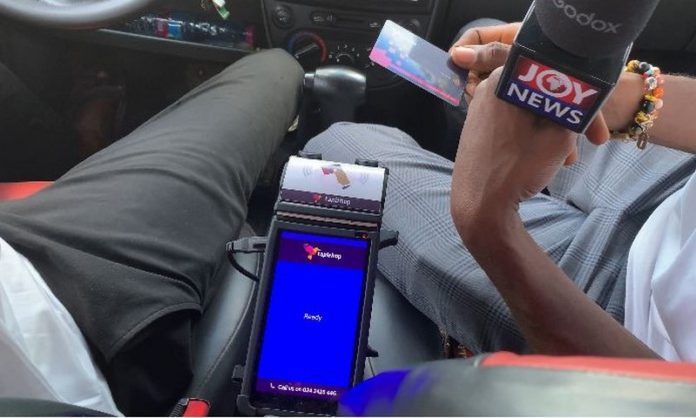Occasional disputes between customers and bus conductors over transport fares is a commonplace in Ghana. Fortunately, an electronic payment system seeks to avert this situation.
In Ghana, taxis and trotros are important means for about 60% of the traveling public.
Inaccurate charges and disagreements over defaced notes arise from the traditional method of paying transportation fares with cash.
The Tap & Hop technology is reshaping this narrative with electronic payment solutions, offering an efficient alternative.
How it works
The Point of Sale device installed in a taxi or trotro, goes with a corresponding ‘e-zwitch’-like card to activate transactions electronically.
Passengers are assigned to a special card. The card is loaded with money from mobile money through the tap&hop app. A tap on the sensor reveals the current position of the passenger, as well as the destination. It then calculates the exact fare based on the distance covered.
“It is a force to drive the digitalisation age and bridge the gap by providing electronic and hand-on assistance with travelling fare payments. It will reduce or stop the litigation from false, unsure and overpayment of fares. The passenger will be able to pay for small denominations that may not exist in physical cash, and it will be an easy way for drivers to collect their money even without conductors. The instances of holding physical money and losing them are reduced,” said Emmanuel Arthur, a Front End Engineer at tap & hop.
Again, the device ensures passengers’ safety and protection of passengers’ personal items.
“The card and the app give access to the information of the driver; in circumstances of need, the driver can be traced, and passengers will be able to retrieve their lost valuables in the car,” Mr. Arthur said.
Passengers/ Commuters enthused?
I engaged some passengers and Commuters about what they make of the device.
Sally, a student who normally take trotro from KNUST to Adum though believes it’s a great idea, she’s concerned the untimely updating of fares may still
cause confusion between passengers and drivers.
“I like the device but If they’re not swift with updates, still the fights won’t stop,” she pointed out.
For Yaa, the idea of not waiting for a change is a great relief.
“Sometimes, you can be there waiting for change and even forget about it. It’s good that will be all gone,” she said.
But Nsiah, a taxi driver who plies the Santasi road is skeptical about high charges drivers are likely to incur from using the device. He says that will be a disincentive.
“If deduct too much charges, we won’t be happy using the machine,” he said.
Expert take
I contacted Stephen Frimpong of Tek devisal to have a look at the system.
First, Stephen believes a way to enhance accessibility is by integrating NFC technology and USSD into the Point of Sale (POS) system to allow passengers to use their mobile phones conveniently.
“This improves the overall transportation payment system by directly impacting the driver’s account through transactions made via mobile apps or USSD. This ensures a smoother experience for passengers and conductors, optimizing efficiency,” he said.
To combat internet challenges, Stephen wants the developers to consider accumulating non-internet transactions under the POS code.
“Assign unique codes to POS systems capable of local payments without internet. This setup allows seamless cash redemption for drivers and car owners, irrespective of internet availability, based on the accumulated amount linked to a specific POS system code,” he directed.
Again, Stephen believes expanding the system’s capabilities to aggregate funds under this unique driver code empowers drivers for credit-based fuel purchases.
“The system maintains a running tally, enabling drivers to settle expenses when redeeming their earnings daily,” he said.
Last, Stephen wants a simplified distance calculations by implementing a tapping system can streamline fare calculation.
“Passengers can tap upon entering and exiting, initiating fare calculation based on these points. Leveraging established transport union rates ensures a familiar approach for passengers, promoting ease of use,” he recommended.
Going nationwide
Mr. Frimpong indicates the need to build trust and familiarity among both drivers and passengers facilitating a widespread adoption of the technology.
“Initially, targeting the driver unions is key. Engaging with these unions and addressing their concerns can foster a sense of partnership and encourage their willingness to adopt the new system.
“Securing the installation of these devices in a few public transport vehicles, possibly within one or two driver unions, marks a significant step forward. Ensuring thorough market research validates the project’s feasibility and relevance to these unions’ needs is crucial,” he said.
Mr. Frimpong also thinks it’ll be important to adopt SIM card technology in order to ensure seamless operation of the system and adoption.
“Implementing 4G (SIM card) technology for connectivity would bypass the need for Wi-Fi in every vehicle, streamlining the setup process,” he’s optimistic.
This report is produced under the DPI Africa Journalism Fellowship Programme of the Media Foundation for West Africa and Co-Develop.
Annor Dompreh is not afraid, we are trying to prevent skirt…


